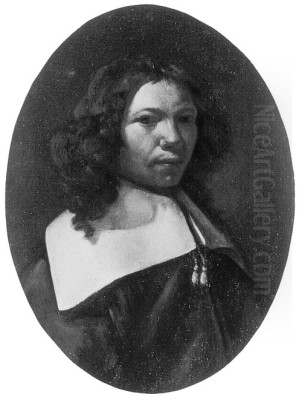
Gerrit Adriaensz. Berckheyde (1638–1698) stands as a pivotal figure in the rich tapestry of Dutch Golden Age art. Renowned for his luminous and meticulously detailed depictions of urban environments, Berckheyde captured the burgeoning prosperity, civic pride, and architectural grandeur of the Netherlands during the 17th century. Working primarily in Haarlem, Amsterdam, and The Hague, he specialized in cityscapes, or 'vedute', elevating the genre through his exceptional skill in rendering perspective, light, and architectural accuracy. His work not only serves as a testament to his artistic prowess but also provides invaluable historical documentation of the cities he portrayed.
Early Life, Training, and Travels
Born in Haarlem in 1638, Gerrit Berckheyde grew up in an environment steeped in artistic activity. His primary training came from his elder brother, Job Adriaensz. Berckheyde (1630–1693), who was also a respected painter. While Job's oeuvre encompassed genre scenes, biblical subjects, and some city views, Gerrit would come to dedicate himself almost exclusively to the architectural landscape. The brothers shared a close bond and a professional partnership throughout much of their lives.
In the 1650s, the Berckheyde brothers embarked on a significant journey through Germany. Their travels took them along the Rhine River, visiting cities such as Cologne, Bonn, Mannheim, and notably Heidelberg. This period proved formative, exposing them to different architectural styles and landscapes. During their time in Heidelberg, they found favour at the court of Charles Louis, Elector Palatine, who appreciated their talents and provided them with patronage. This experience likely broadened Gerrit's artistic horizons and perhaps reinforced his interest in depicting grand structures and urban settings.
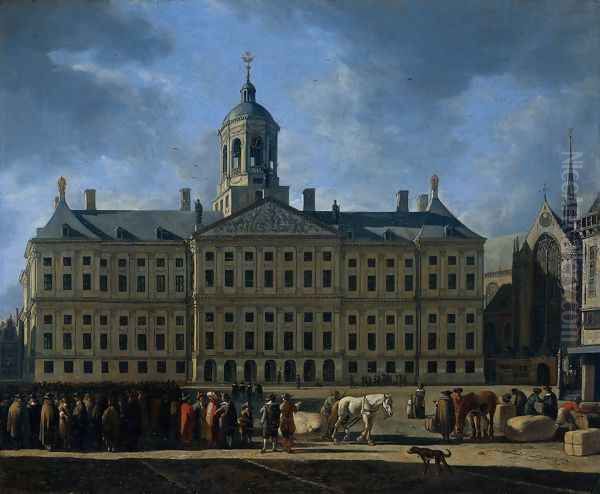
Upon their return to the Netherlands, Gerrit settled back in his native Haarlem. A key moment in his burgeoning career occurred on 27 July 1660, when he was officially admitted to the Haarlem Guild of Saint Luke. Membership in the guild was essential for artists wishing to practice professionally, sell their work, and take on apprentices (though Berckheyde is not known to have had any students). This marked his formal establishment as an independent master painter within the vibrant Haarlem art scene. He remained associated with the guild throughout his career, later also participating in activities with the guild in The Hague, including drawing from live models.
Artistic Style and Meticulous Technique
Gerrit Berckheyde's artistic signature is defined by clarity, precision, and an extraordinary sensitivity to light and atmosphere. His primary focus was the accurate representation of existing buildings and city squares, rendered with near-photographic detail. He possessed a masterful command of linear perspective, creating convincing illusions of depth and spatial recession that draw the viewer into the scene. His compositions are often characterized by strong diagonal lines, leading the eye towards a focal point, typically a significant civic or religious building.
A defining feature of Berckheyde's work is his treatment of light and shadow. He excelled at capturing the effects of natural sunlight illuminating facades, casting crisp shadows, and creating a sense of time and weather. His skies are often clear, allowing the sun to model the architectural forms distinctly. This use of light is not merely descriptive; it imbues his cityscapes with a sense of calm, order, and often a bright, airy quality. The interplay of light and shadow enhances the three-dimensionality of the buildings and animates the urban space.
Compared to his brother Job, Gerrit's approach was generally more focused on the broader urban vista and architectural exactitude, often favouring expansive views of squares and streets rather than the more intimate genre scenes or interiors sometimes tackled by Job. While influenced by pioneers of architectural painting like Pieter Jansz. Saenredam (1597–1665), known for his serene and precise church interiors, Berckheyde applied a similar meticulousness to the external urban environment. Unlike Saenredam's often depopulated interiors, Berckheyde's cityscapes are usually subtly populated with figures that add scale and life without distracting from the architectural focus.
Berckheyde's technique involved careful observation and likely the use of preparatory drawings, although few survive. His application of paint was typically smooth and controlled, allowing for the fine rendering of brickwork, windowpanes, and decorative elements. He often employed a warm palette, particularly in his depictions of brick buildings, contrasted with the cooler tones of stone and sky. This combination of precise drawing, controlled execution, and masterful light effects resulted in works of remarkable realism and enduring appeal.
Major Themes: Celebrating the Dutch City
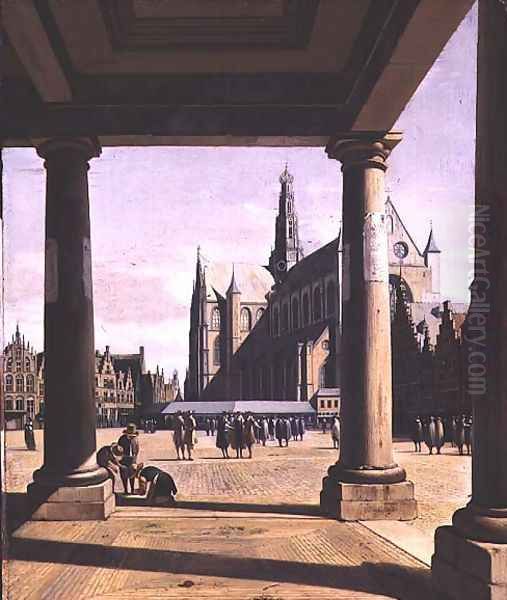
The heart of Gerrit Berckheyde's oeuvre lies in his celebration of the Dutch city during its Golden Age. His paintings predominantly feature views of Haarlem, Amsterdam, and The Hague, the political and economic powerhouses of the Dutch Republic. These works capture the essence of urban life, reflecting civic pride, commercial success, and the well-ordered nature of Dutch society.
Haarlem, his hometown, was a frequent subject. Berckheyde painted numerous views of the Grote Markt (Great Market Square), dominated by the imposing Grote Kerk or Sint-Bavokerk (St. Bavo's Church). These paintings, such as The Great Market at Haarlem, often depict the bustling market activity, showcasing the square as the city's social and economic hub. He meticulously rendered the varied facades of the surrounding buildings, including the Town Hall and the Vleeshal (Meat Hall).
Amsterdam, the rapidly expanding commercial capital, provided Berckheyde with ample inspiration. He was particularly drawn to the new Town Hall on Dam Square (now the Royal Palace), a potent symbol of Amsterdam's wealth and power. He painted this monumental structure from various angles and under different lighting conditions, capturing its classical grandeur. His views often include the Waag (Weigh House) and the Nieuwe Kerk (New Church), presenting Dam Square as a stage for civic life.
Berckheyde also famously depicted Amsterdam's elegant canals, most notably the Herengracht. His painting View of the Golden Bend (Gouden Bocht) in the Herengracht is one of his most celebrated works. It portrays the prestigious curve in the canal lined with the newly built, luxurious mansions of Amsterdam's wealthiest merchants. The painting exudes an air of prosperity and refined urban living, perfectly capturing the elite character of this district.
The Hague, the seat of government, also featured in Berckheyde's work. He painted views of the Binnenhof (the government complex), the Hofvijver (the Court Pond), and surrounding areas. Works like A Hunting Party near the Hofvijver in The Hague combine architectural elements with landscape and genre details, showcasing the city's role as a centre of power and aristocratic life. His depictions often emphasize the harmonious integration of architecture and nature within the urban setting.
Beyond specific cities, Berckheyde's themes included the depiction of public squares, monuments, and the general architectural fabric of the Dutch urban landscape. His work consistently conveys a sense of order, cleanliness, and prosperity, reflecting the ideals of the Dutch Republic.
Key Works and Detailed Observations
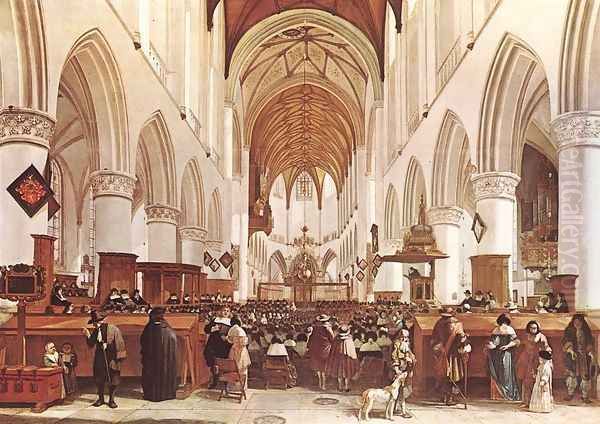
Several paintings stand out in Gerrit Berckheyde's extensive body of work, estimated to number between 259 and 261 extant pieces. His depictions of the Amsterdam Town Hall are numerous and significant. Works like The Town Hall on the Dam, Amsterdam (found in various collections, including the Rijksmuseum and the National Gallery, London) showcase his ability to handle complex architectural forms and large public spaces. He captures the building's imposing scale and classical details, often including small figures on Dam Square to provide context and animation.
The Great Market at Haarlem with St. Bavo's Church (e.g., Frans Hals Museum, Haarlem) is another recurring subject. Berckheyde masterfully balances the towering Gothic architecture of the church with the lively activity of the market square below. His attention to detail extends to the textures of the buildings, the goods being sold, and the interactions of the townspeople. These paintings serve as vibrant snapshots of 17th-century Haarlem life.
The View of the Golden Bend (Gouden Bocht) in the Herengracht, Amsterdam (Rijksmuseum, Amsterdam) is perhaps his most iconic canal view. Painted around 1671-72, it depicts the newly completed, fashionable mansions along the Herengracht. The composition emphasizes the graceful curve of the canal and the uniformity yet individuality of the houses. The calm water reflects the facades, enhancing the serene and prosperous atmosphere. The painting is a prime example of Berckheyde's ability to capture the unique character of Amsterdam's urban landscape.
An interesting aspect of Berckheyde's work is his attention to small, sometimes anecdotal details. In one view of the Grote Kerk in Haarlem, he includes a small figure of a stonemason actively working with a hammer and chisel, adding a touch of narrative realism. Similarly, his paintings sometimes feature detailed renderings of coats of arms inscribed on church floor slabs. Art historians note that he occasionally depicted these details speculatively, perhaps even before they were physically added to the church, indicating a deep interest in heraldry and architectural finishing touches.
A somewhat unusual work is his depiction of the East Facade of the Portuguese Synagogue in Amsterdam. While primarily known for civic and Protestant church exteriors, this painting tackles a significant religious building of Amsterdam's Jewish community. Interestingly, art historical research suggests some details in the painting, like certain sheds or the extent of the foreground paving, might not perfectly align with historical records or the building's actual state at the time, possibly indicating artistic license or reliance on preliminary designs.
Collaboration, Contemporaries, and Context
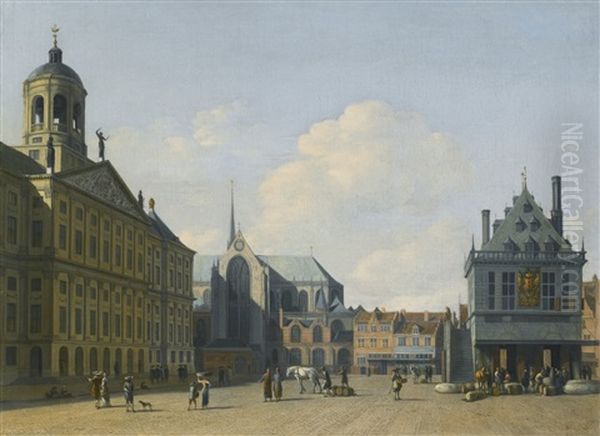
Gerrit Berckheyde's closest artistic relationship was undoubtedly with his brother, Job. They shared a studio for many years after returning from Germany, and their styles, while distinct, show mutual influence. Job's work sometimes included architectural backgrounds that echo Gerrit's precision, while Gerrit's populated scenes benefited from the figure-painting skills prevalent in genre painting, a field Job explored more extensively.
While Berckheyde is not documented as having formal students, his meticulous style suggests he may have occasionally employed specialists for the 'staffage' – the small figures and animals that populate his cityscapes. Art historians suggest that artists like Johannes Lingelbach (1622–1674), known for his lively Italianate scenes and figures, and perhaps the younger Jan van Huchtenburgh (1647–1733), a specialist in battle scenes and horses, may have contributed figures to some of Berckheyde's canvases under his direction. This was a common practice in the highly specialized Dutch art market.
Berckheyde worked during the peak of the Dutch Golden Age, alongside many other renowned painters. His focus on cityscapes places him in dialogue with artists like Jan van der Heyden (1637–1712), another master of the urban view, known for his incredibly fine detail, particularly in rendering brickwork, and sometimes more panoramic perspectives. While both excelled at architectural accuracy, Berckheyde's work often possesses a stronger sense of atmospheric light and spatial clarity compared to Van der Heyden's intense focus on texture.
His work can also be contextualized alongside architectural painters like Emanuel de Witte (c. 1617–1692), who specialized in church interiors but brought a remarkable sensitivity to light and atmosphere, often creating more dramatic and populated scenes than Saenredam. Although focused on different subjects, the shared interest in accurately representing space and light connects them.
Furthermore, Berckheyde's contemporaries included giants like Johannes Vermeer (1632–1675), whose View of Delft demonstrates a similar interest in capturing the light and atmosphere of a specific urban location, albeit with a different painterly technique. Pieter de Hooch (1629–1684), famous for his domestic interiors and courtyard scenes, also meticulously rendered architectural settings and explored effects of light and perspective, sharing common ground with Berckheyde's spatial concerns. Even landscape painters like Jacob van Ruisdael (c. 1628–1682), known for his dramatic natural scenes, occasionally painted city views (like his View of Haarlem) that show an interest in topography and atmosphere, while earlier artists like Hendrick Avercamp (1585–1634) had established traditions of depicting towns within lively winter landscapes. Berckheyde's specific contribution was the dedicated, detailed, and often monumental portrayal of the contemporary Dutch city itself.
Later Life, Legacy, and Influence
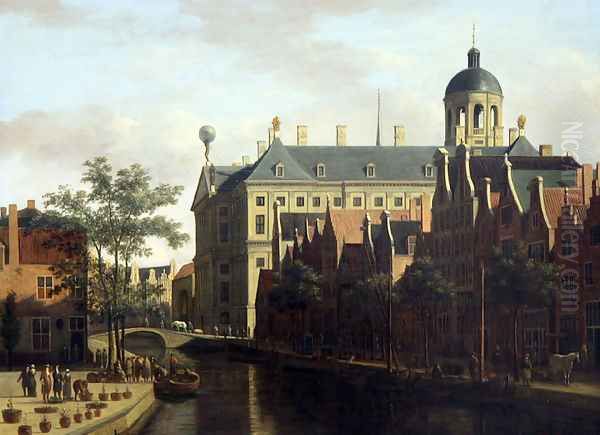
Gerrit Berckheyde continued to paint actively throughout his life, maintaining a high level of quality and consistency. He remained based primarily in Haarlem but likely made frequent trips to Amsterdam and The Hague to sketch and gather material for his paintings. His works were sought after by collectors who appreciated their accuracy and their celebration of Dutch urban achievement. Contemporary poets praised the Berckheyde brothers, recognizing their skill in capturing the beauty of their surroundings.
His life ended tragically in 1698 when he drowned in the Spaarne canal in Haarlem. Despite his success, he apparently never married and lived with his brother Job until Job's death five years earlier.
Gerrit Berckheyde's legacy is significant. He was one of the leading cityscape painters of the Dutch Golden Age, perfecting a genre that reflected the unique character of the Dutch Republic. His paintings are more than just topographical records; they are carefully composed works of art that convey a sense of order, light, and civic harmony. They provide an invaluable visual archive of 17th-century Dutch architecture and urban planning.
While he did not have direct pupils, his influence extended to later generations of cityscape painters. Artists active in the late 17th and 18th centuries, such as Timotheus de Graaf and Jan ten Compe (1713–1761), continued the tradition of detailed urban views, clearly indebted to the standards set by Berckheyde and Van der Heyden. His work, alongside that of his contemporaries, helped establish the cityscape as a respected and distinct genre within Dutch art.
Today, Gerrit Berckheyde's paintings are held in major museum collections across the world, including the Rijksmuseum in Amsterdam, the Mauritshuis in The Hague, the Frans Hals Museum in Haarlem, the National Gallery in London, the Louvre in Paris, the Hermitage Museum in Saint Petersburg, the Los Angeles County Museum of Art (LACMA), and the Royal Museum of Fine Arts in Antwerp, among many others. His work continues to be admired for its technical brilliance, historical significance, and evocative portrayal of the Dutch Golden Age city. His paintings were also featured in significant exhibitions focusing on the era, such as "Dutch Cityscapes of the Golden Age" (The Hague, 2009) and exhibitions showcasing Dutch masters internationally.
Conclusion: Architect of the Painted City
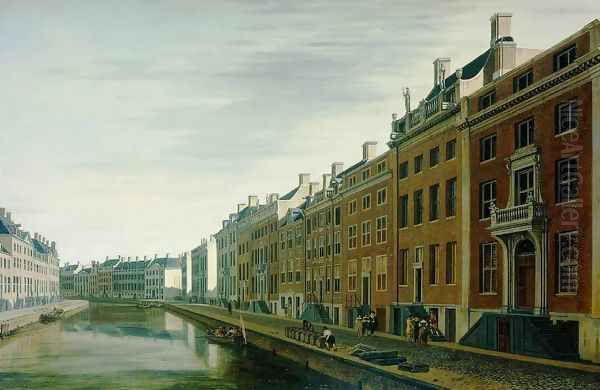
Gerrit Adriaensz. Berckheyde remains a cornerstone figure in the study of Dutch Golden Age painting. As a dedicated specialist in the cityscape, he brought an unparalleled level of precision, clarity, and sensitivity to light to his depictions of Haarlem, Amsterdam, and The Hague. His work transcends mere topography, offering carefully constructed visions of urban order, prosperity, and civic pride that resonated deeply with his contemporaries and continue to captivate viewers today. Through his meticulous brushwork and keen observational skills, Berckheyde not only documented the architectural triumphs of his time but also crafted enduring works of art that celebrate the unique character and atmosphere of the Dutch city at the zenith of its influence. His contribution firmly established the cityscape as a major genre and left behind a legacy of luminous, detailed paintings that stand as timeless tributes to the urban world of the 17th-century Netherlands.